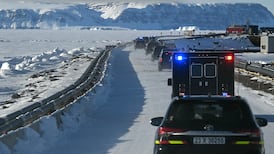Thousands of protesters were expected to take to the streets of New York on Friday in a third day of demonstrations against police violence.
The demonstrations come despite prosecutors saying they would consider charges against an officer for the fatal shooting of an unarmed black man in November.
The shooting of Akai Gurley, in a dark stairwell in Brooklyn added to a string of police actions involving unarmed black men that have inflamed racial tensions throughout the United States.
Since Wednesday, when a New York grand jury cleared white police officer Daniel Pantaleo in the July chokehold death of 43-year-old father-of-six Eric Garner, the city has seen two nights of angry but largely peaceful demonstrations.
The decision was announced nine days after another grand jury declined to indict a white policeman for the killing in August of an unarmed black teenager in Ferguson, Missouri, spurring rioting in the St Louis suburb.
On Thursday in Phoenix, Arizona, another unarmed black man was shot dead by a white police officer during a scuffle, leading to protests there.
“The government has created a monster and the monster is now loose,” said Soraya Soi Free, a nurse and activist from the Bronx who has been participating in New York protests.
A wake for Gurley is scheduled for Friday night, with his funeral to follow on Saturday.
Civil rights leader Reverend Al Sharpton will deliver the eulogy.
Brooklyn District Attorney Kenneth Thompson said he will convene a grand jury to consider charges against the officer who shot Gurley, the Wall Street Journal reported. The officer, Peter Liang, has said his gun discharged accidentally.
At a press conference with Gurley’s relatives on Friday, Kevin Powell, the president of the advocacy group BK Nation, called the shooting part of a “series of modern-day lynchings”.
Gurley’s mother, Sylvia Palmer, tearfully demanded justice for her son.
Other planned events in New York on Friday include a candlelight vigil for Garner.
Occupy Wall Street, the movement that arose in 2011 to protest economic inequality, is holding a “speakout” Friday afternoon in Manhattan to protest the Garner decision, said Sumumba Sobukwe, an Occupy organizer.
Soft approach
New York police have tried to take a soft approach during this week’s protests, steering marchers away from a nationally televised Christmas tree lighting ceremony Wednesday, but otherwise allowing them to proceed unhindered.
Tensions briefly erupted late Thursday in Times Square as a multiracial crowd of about 3,000 protesters blocked a major intersection, chanting at police, “Who do you protect?”
Hundreds of officers responded, shoving protesters onto sidewalks. A police spokesman said Friday more than 200 protesters had been arrested, but declined to provide additional details.
In a sign of national concern about the issue, US president Barack Obama has asked Philadelphia’s top police officer to recommend ways to rebuild public trust in police.
“There is a tension, there are real issues,” Philadelphia police commissioner Charles Ramsey said in an interview. “They lost faith in us to a large extent, and we’ve got to restore that.”
US attorney general Eric Holder has said the Justice Department will pursue civil rights investigations into both the Missouri shooting and the New York case, though legal experts have said federal charges for the two officers are unlikely.
Chokeholds
Unlike the August 9th shooting of 18-year-old Michael Brown in Missouri, Garner’s encounter with New York police was captured on video. It showed Mr Pantaleo wrapping his arm around Garner’s throat and wrestling him to the sidewalk as three other officers helped subdue him.
Garner, who was asthmatic, repeatedly gasped, “I can’t breathe” – a phrase protesters have taken up as a rallying cry.
He was being arrested on suspicion of selling cigarettes illegally.
Mr Pantaleo could still face disciplinary action from an internal police investigation, his lawyer said. Chokeholds are banned by police department regulations.
Mr Pantaleo told the grand jury he used a proper takedown technique and never put pressure on Garner’s neck, according to his lawyer, Stuart London. The city’s medical examiner has said Garner’s death was caused by compressing his neck and chest, with his asthma and obesity contributing.
Reuters











